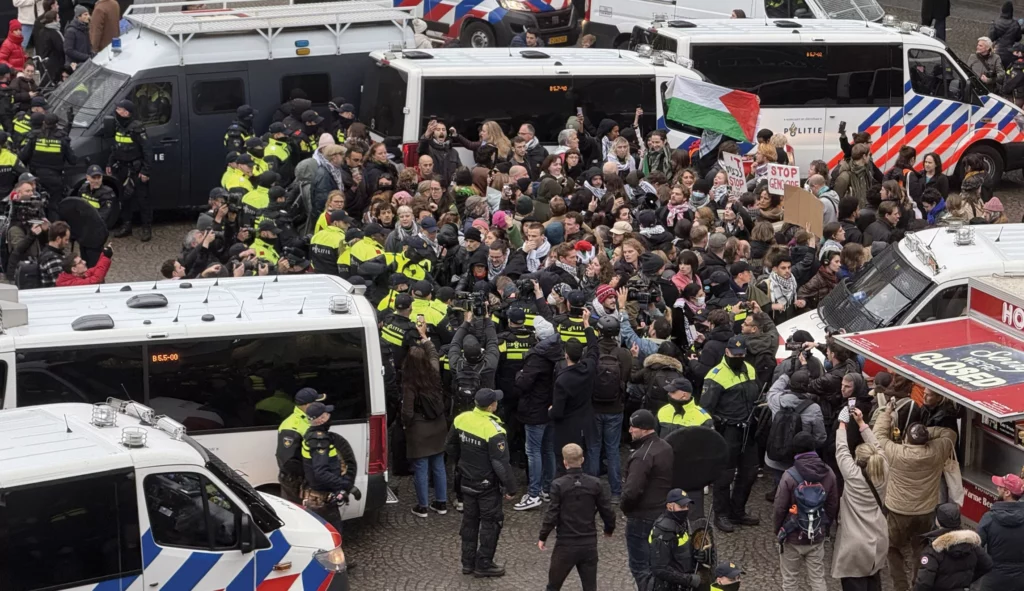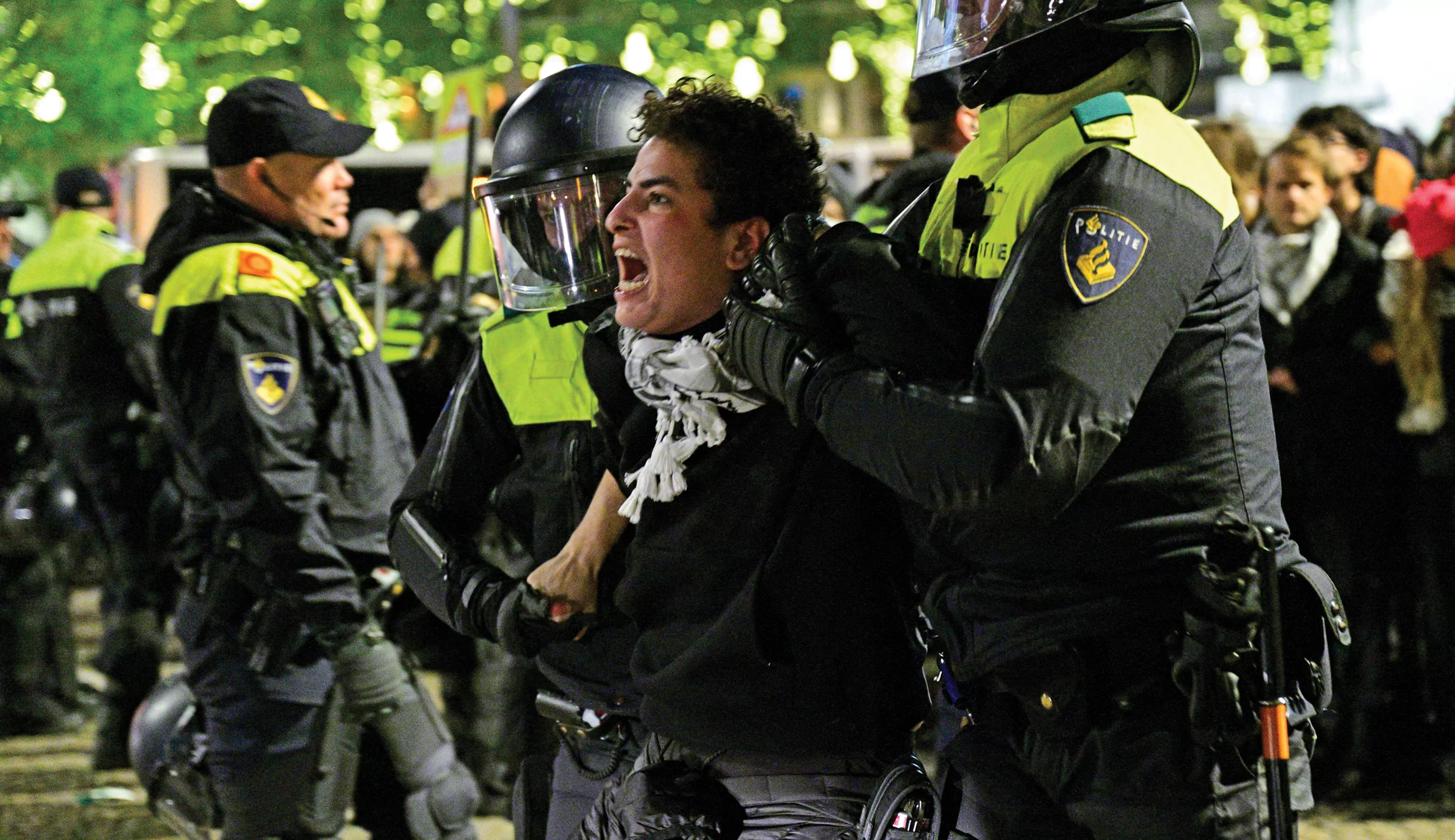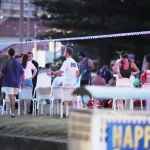
“What is done cannot be undone,” Anne Frank wrote in her eponymous diary some 80 years ago, “but one can prevent it happening again.”
I had occasion to reflect on young Anne’s words during my visit to her hiding place in Amsterdam, a tiny warren of rooms on the fifth floor of a spice warehouse overlooking a picturesque canal.
But little did I appreciate just how prescient she was: Only a few hours later, following a soccer match between local favorite Ajax and Maccabi Tel Aviv, Jews in Amsterdam would once again find themselves hunted, rounded up, and beaten unconscious by a well-organized mob of totalitarian antisemites in a pogrom justifiably likened to Kristallnacht, the Night of Broken Glass, in 1938.

Just as Europe fell prey to Nazism, as liberalism proved unable to resist the advances of authoritarian ideology, and as good people allowed evil ones to perpetrate mass violence against the Jews, Europeans today have evinced dangerous signs of surrendering legally, politically, and militarily to the forces of jihadism. Instead of preventing a recurrence of the nightmare of the 1930s and ’40s, the Western world is allowing it to happen again.
Prinsengracht 263
Anne Frank Huis boasts nearly a million visitors every year, and I proudly counted myself among them this month during a 12-hour layover in Amsterdam.
From the outside, the stately home looks like any lining the stylish Prinsengracht — brick-faced, spotless, and gable-roofed. The ordinariness of the building served as its greatest asset: hiding Anne, her sister Margot, their parents Edith and Otto, and four other Jews who took refuge in the structure’s “secret annex” in July 1942, after the Nazis tightened their control over the city and ordered Margot to appear for deportation.
Anne and her family had fled to the Netherlands from their native Frankfurt following the Nazi rise to power. But while the museum highlights the righteousness of many Dutch gentiles who protected the city’s centuries-old Jewish population, far too many Netherlanders welcomed or at least made their peace with Hitler’s invasion.
As the Nazis closed in, ultimately murdering three-quarters of Amsterdam’s 80,000 Jews, Anne and company slept in impossibly cramped quarters behind a false bookshelf, ate little, and stayed silent during waking hours to avoid detection. Anne documented her ordeal both in artwork that decorates the tiny bedroom she shared and in a series of journals that she later rewrote and compiled into her famous diary, preserved under glass in the museum.
But just weeks after D-Day, the SS located Anne and her family, who apparently were betrayed by Dutch acquaintances. Anne and Margot were transported to Bergen-Belsen, where they both perished. Edith and Otto were dispatched to Auschwitz, where she was murdered and which he survived, ultimately returning to Amsterdam to recover and publish Anne’s diary.
For decades, the Dutch and other Western Europeans acknowledged their shameful participation in the Nazis’ murderous depredations, and Anne became the symbol of pure goodness violated by sheer evil. “Never again,” they vowed, would liberal society give way to totalitarianism. Never again would Jews fear for their lives in civilized countries. But that resolve didn’t last long.
A jihadist playground
Tragically, in recent decades, the Netherlands in general, and Amsterdam specifically, has become, under the noses of the very elites purporting to stand for liberalism, extraordinarily congenial territory for Islamist, and specifically antisemitic, activism.
Massive immigration from North Africa and the Middle East, coupled with anemic efforts to assimilate new arrivals into Dutch culture, has stoked the fires of hatred of Jews, Israel, and the West in general.
Twenty-two years ago, the gay Dutch politician Pim Fortuyn was shot to death by a left-wing activist seeking “to protect Muslims.”

Two years later, the filmmaker Theo van Gogh was murdered on his doorstep by a Moroccan immigrant infuriated by the documentary he directed about Ayaan Hirsi Ali, the intellectual and Dutch member of parliament who had fled Islamist oppression in Somalia for the Netherlands.
Like Anne Frank, Hirsi Ali herself then went into hiding, emerging only under the heavy protection of bodyguards. She eventually fled Holland for the United States after Dutch authorities, spooked by the Islamist furor, threatened to revoke her citizenship.
Growing jihadist strength in Amsterdam’s suburbs, along with security forces’ increasing fear of these areas, caused one leading politician, as Douglas Murray recently recalled, to declare in 2010 that “I see no future for recognizable Jews” in the country.
Then came Oct. 7, 2023. And then came the pogrom.
Jews under attack — again
Earlier in the day on Nov. 7, in central Amsterdam, I happened to encounter two eager Maccabi fans, proudly displaying their team’s blue and yellow colors while sightseeing. As I took a group selfie, we exchanged pleasantries, and I ribbed them for backing the wrong club (my 17-year-old son supports their rivals, Hapoel Tel Aviv). Little did any of us know what would unfold later that night.
Shortly after Ajax defeated Maccabi 5-0 and fans began pouring out of Johan Cruyff Arena, southeast of the city center, large groups of masked and hooded Moroccan and Turkish immigrants began to attack the Jewish fans, chanting “Free Palestine” and “kankerjoden,” or “Cancer Jew,” a popular taunt in Holland. Jews were thrown into canals, beaten on sidewalks, chased into hotels and restaurants, and kicked in the streets. Dozens of Jewish fans were injured. As many as 10 were hospitalized. Others pleaded that they were not Jewish. Yet others, like Anne Frank, went into hiding wherever they could find shelter.
The pogrom was apparently planned well in advance of the match, with instigators tracking and disseminating the flight and hotel information of the visiting fans. “They were waiting in groups at every corner,” one Maccabi supporter told an Israeli news outlet, “and the moment they identified Jews, they chased them.” Another called the lynchings “Kristallnacht 2.” Amsterdam’s mayor described the attacks as “people going on a Jew hunt.”
Where were the police? Almost nowhere to be found.
One minor reported asking police to assist him after he’d been brutally beaten. “You’ll be fine on your own,” they told him. “The Dutch police abandoned us,” another said. Some shell-shocked fans told a reporter that officers instructed Maccabi supporters not to take taxis because cab drivers were orchestrating the attacks.
According to one horrific report, Dutch police arrested a Jewish man and his 14-year-old grandson who were holding sticks to defend themselves against the mob. Officers allegedly ordered them to lie down, kicked them, and tossed them into a police van whose interior was adorned with “Free Palestine” stickers.
The Oct. 7 effect
Hamas’s savage Oct. 7, 2023, invasion of Israel occasioned the most recent explosion of antisemitism in Amsterdam, as it has in other Western European capitals.
Just three days after the attack, the Netherlands Student Coalition issued a pro-Hamas Facebook post featuring a photo of the breached border fence and an illustration of a paraglider, proclaiming, “Glory to Gaza and all of Palestine for their daring and exemplary resistance!”
In March, pro-Palestinian activists protested Israeli President Isaac Herzog’s inauguration of the Netherlands’ National Holocaust Museum.
In May, pro-Hamas protesters struck a Jewish man in the head with a wooden plank during an out-of-control demonstration on the campus of the University of Amsterdam.
Dozens of other violent protests have engulfed the country, with authorities seemingly powerless to confront them. (During a very short visit to Amsterdam last month, my family and I were startled to witness a few dozen pro-Palestinian protesters screaming and rampaging through the center of town at 9 in the evening.)
Much of this unrest has been fueled by the explosive campaign being mounted against Israel nearby in The Hague, where South Africa, joined by several other countries, has slanderously accused Israel of perpetrating genocide against the Palestinians. The International Court of Justice proceedings have predictably sparked yet further virulently anti-Israel protests.
In parallel, Karim Khan, the prosecutor of the International Criminal Court, is ludicrously seeking arrest warrants for Israel’s prime minister and former defense minister for “crimes against humanity.” In a perverse moral inversion, Khan likened Israel’s defensive war against the genocidal movements of Hamas and Hezbollah to Nazism, saying earlier this week that “we have failed to live up to the promise of Never Again that was made in Nuremberg.” Khan is himself under investigation for sexual misconduct.
This vicious lawfare waged against Israel dovetails with the goals of the jihadists: to anathematize the Jewish state and the Jewish people and to exclude them legally, politically, and physically from civilized society. Anne Frank would surely recognize this effort.
So what is to be done?
Fighting back
Shortly before heading to the airport, I visited Oude Kerk, Amsterdam’s 13th-century “Old Church,” which has been converted into a contemporary art museum. The exhibit inside the cavernous gothic building was impressive — laser displays, fishing wire, a 6-foot-cubed black box — and it wasn’t inappropriate for a once-holy place.
But my overwhelming emotion was sadness: Why is this stunningly beautiful place of worship empty? Where is the vibrancy of traditional Western practices and ideas? Holland’s seminal contributions to the Enlightenment — religious freedom, scientific rigor, and open inquiry incepted by Erasmus, Spinoza, and Grotius, among many others — are conspicuously absent.
Turning the tide will take determined leadership from Dutch officials, beginning with Prime Minister Dick Schoof, who leads a center-right coalition, labeled the attacks “completely unacceptable,” and vowed that “the perpetrators will be identified and prosecuted.”
It will require continued pressure from the likes of Geert Wilders, the controversial champion of liberty and leader of the PVV, Holland’s largest political party — and a longtime ally of Hirsi Ali — who pronounced himself “speechless” that the pogrom instigators were not promptly arrested.
And it will entail much more committed policing from Dutch public security forces who are now encountering yet more violence as they belatedly make arrests.
CLICK HERE TO READ MORE FROM THE WASHINGTON EXAMINER
They might channel the courage of Melhem Asad, a Druze Arab from northern Israel, who, at great personal risk, confused the attackers by shouting in Arabic, drawing them away from vulnerable Jewish fans.
If the Dutch, Europe in general, and the Western world at large truly seek to channel Anne Frank and “prevent it happening again,” we’ve all got our work cut out for us.
Michael M. Rosen is an attorney and writer in Israel and a nonresident senior fellow at the American Enterprise Institute.






